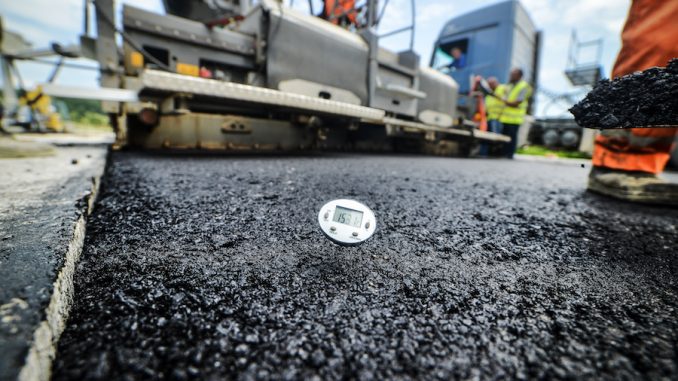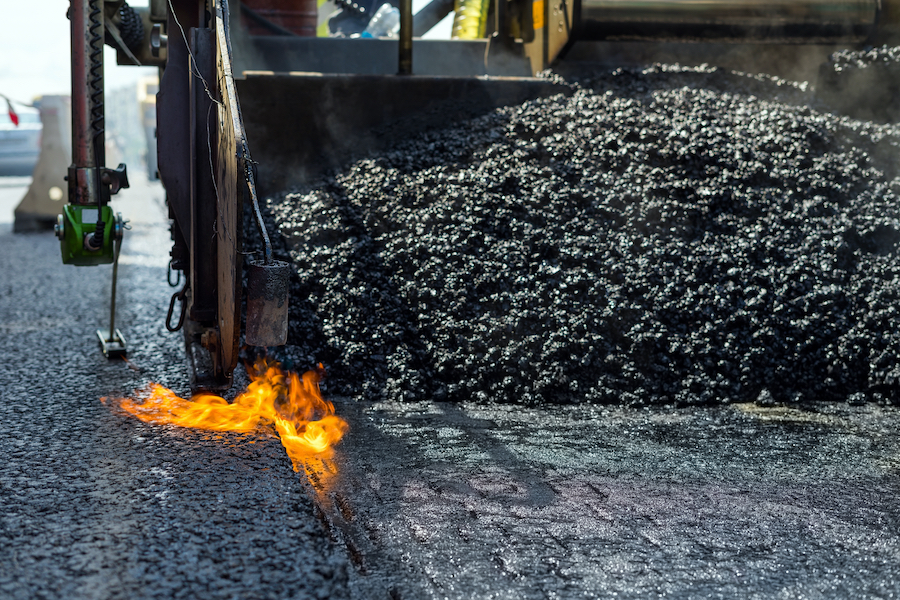
This checklist was originally created by the U.S. Department of Transportation Federal Highway Administration. September 2013. Publication No. FHWA-HIF-13-061.
This checklist encompasses the three main hot in-place asphalt recycling (HIR) processes:
- Surface recycling,
- Remixing, and
- Repaving.
Surface Recycling consists of scarifying/milling the pavement to the required depth, adding a rejuvenating agent, if required, mixing, placing and compacting the recycled mixture.
Remixing consists of scarifying/milling the pavement to the required depth, adding a rejuvenating agent and admixture (new aggregate or hot mix asphalt (HMA)), if required, mixing, placing and compacting the recycled mixture.
Repaving combines the Surface Recycling or Remixing process with the placement of a simultaneous or integral overlay of new HMA.
Some of the issues addressed in this checklist may not apply to all three of the processes.
This document is a field guide which is not intended to replace project specifications.
PRELIMINARY RESPONSIBILITIES
This section includes documents and information that should be available prior to any construction activities.
DOCUMENT REVIEW
- Project specifications
- As-built plans, if available
- Mix design
- Construction manual
- Traffic control plan
- Owner/Agency requirements
- Additive manufacturers’ instructions
- Safety Data Sheets (SDSs)
- Health and Safety Plan and Job Hazard Analysis

PROJECT REVIEW
- Note the types of distresses that exist and consider the cause and severity of each.
- Consider whether distresses are primarily limited to one of the following: aging, raveling, potholes, bleeding, inadequate surface friction, rutting less than ½ inch (<12.5 mm), corrugations, shoving, light cracking, or ride quality due to minor to moderate distresses in the upper 2-3 inches (50-75 mm) of the pavement section.
- Consider whether existing materials are of sufficient quality to be recycled or if the mixture will need to be improved via the addition of admixtures (new aggregates or HMA) during the recycling process.
- Determine whether cutback asphalts or heavy crack sealants have been used as surface treatments in the past. The presence of flammable solvents or rubberized materials may preclude the use of HIR methods.
- Consider whether any pavement distresses are the result of base or subgrade failure. Has other testing confirmed the presence of a weak underlying layer?
- Visually examine the current surface and subsurface drainage conditions and confirm they are sufficient to prevent surface deterioration and softening of the subgrade and will enable long-term performance of the pavement after HIR treatment.
- Verify that cores from both the center and edge of the pavement, to confirm the thickness of the bituminous layers, have been obtained at various locations along the project.
- Determine whether the existing pavement can support the expected traffic loading during the design life without additional strengthening.
- If strengthening is required in certain locations, determine the thickness of HMA that is required to support the anticipated traffic.
- Review existing ride measurements and correct any issues that could adversely affect the ride quality of the final recycled project.
- Determine whether any geometric corrections, e.g., alignment and width, are required during the design period.
- Determine whether any paving fabric is present within 1 inch (25 mm) of the layers to be recycled.
- Ensure that the environmental impact assessment of the project on the surrounding area has been completed.
MATERIALS CHECKS
- Determine whether cores and samples were obtained as part of the subsurface investigation.
- Examine samples for consistency over the length of the project.
- Note the presence of any surface treatments, paving fabrics, or exotic mixes.
- Select the appropriate HIR process to correct deficiencies found in the field investigation.
PRE-CONSTRUCTION INSPECTION RESPONSIBILITIES
This section identifies activities that should be performed before proceeding with construction activities.
PRE-CONSTRUCTION MEETING
- Ensure that all necessary contractor and agency personnel attend the preconstruction meeting.
PAVEMENT PREPARATION
- Ensure that any areas with drainage problems and isolated areas of base failure are repaired in accordance with the contract documents prior to starting HIR-related construction.
- Ensure that the pavement surface profile can be restored to the profile required in the contract documents by cold planing or preliminary leveling of localized areas of excessive deformation, i.e. 1 inch (25 mm) rutting or abrupt vertical change such as an overlay at a concrete joint.
- Ensure the pavement surface is clean and free of deleterious materials.

EQUIPMENT INSPECTIONS
Preheaters
- Verify that the number of preheaters is adequate to sufficiently heat the pavement to facilitate scarification to the depth specified in the contract documents typically a pavement surface temperature of 230 °F to 300 °F (11 °C to 149 °C).
- Verify that each preheater unit is equipped with an enclosed or shielded thermal containment hood capable of heating the pavement surface to the required temperature.
- Verify that the preheater hood is a minimum of 4 inches (100 mm) wider than the scarification on either side of the machine.
Milling/Scarifying Units
- Verify that the milling/scarifying units are capable of scarifying the existing pavement surface to the required depth.
- Verify that the milling/scarifying units are equipped with height controls to facilitate clearance of manholes and other obstructions in the pavement surface.
Rejuvenating Agent and Admixture System
- Verify that the discharge rate of the rejuvenating agent and admixture (new aggregates or HMA) is calibrated relative to the forward speed of the recycling unit so that the quantity of material added is consistent with the contract documents.
- Verify that the recycling unit is equipped with meters that show continuous readout for monitoring of quantities required in the contract documents.
Mixing System
- Verify that the mixing system is capable of thoroughly mixing the scarified material with rejuvenating agent and/or admixture (new aggregate or HMA) in accordance with the contract documents.
Spreaders
- Verify that the equipment includes a form of spreader box and screed capable of spreading and leveling the blended material uniformly over the width of the pavement being processed, in accordance with contract documents.
Paver (Repaving)
- Verify that the paving machine is capable of automatically matching a longitudinal joint in accordance with contract documents.
- Verify that the screed pulled by the paving unit is equipped with slope and grade controls capable of automatic screed leveling to construct the pavement to the line and grade specified in the contract documents.
- Verify that sufficient heat is maintained on the screed to prevent scraping, scoffing, or gouging of the newly completed surface.
Rollers
- Verify that the rollers onsite are of the type, width, and operating weight specified in the contract documents.
- Verify that the number of rollers is sufficient to keep up with the process in accordance with the contract documents.
- Verify that water systems are installed and working on all rollers as required by the contract documents.
- Verify that working scrapers are in place on all rollers as required by the contract documents.
WEATHER REQUIREMENTS
- Verify that the ambient air temperature meets contract specifications, typically the same as for hot mix asphalt, a minimum of 45 °F (7 °C) in the shade.
- Verify that no significant precipitation is predicted within construction operations, in accordance with contract documents.
- Consider that variations in temperature, humidity, and wind conditions will affect breaking and curing times. Specifications typically require that fog is not present during construction operations. Consider that at high altitudes, greater than 6500 feet (1980 m), the effect of temperature needs to be taken into account.
MIX DESIGN (WHEN REQUIRED)
- Verify that a mix design has been performed and that the resulting mixture characteristics meet the specifications required by the contract documents.
- Verify that any special instructions included with the mix design are incorporated into the contractor’s preparation for construction operations.
- Verify that the contractor has submitted the final mix design to the owner/agency for review and approval prior to initiation of construction operations.
TRAFFIC CONTROL
- Verify that the traffic control plan complies with the contract documents and the Manual on Uniform Traffic Control Devices (Federal Highway Administration, 2009).
- Verify that the signs and devices erected on the roadway match the traffic control plan contained in the contract documents.
- Determine whether conditions warrant use of a pilot vehicle.
- Ensure that flaggers do not hold the traffic for extended periods of time.
- Ensure that flaggers do not hold traffic over freshly placed material.
- Ensure that signs are removed or covered when they no longer apply.
- Ensure that an appropriate action plan is developed and implemented for emergency vehicles passing through the project.
- Ensure that any unsafe conditions are reported to a supervisor or the proper law enforcement officials.
PROJECT INSPECTION RESPONSIBILITIES
This section identifies activities that should be performed during the construction process.
PREHEATERS
- Verify that the surface and internal areas of the pavement are dry to decrease energy demand during the HIR process.
- Verify that the asphalt pavement surface is being sufficiently softened, typically at temperatures of 230 °F to 320 °F (110 °C to 160 °C), to facilitate scarification/milling without undue aggregate degradation.
- Ensure that the asphalt pavement surface is not being burned or charred, which typically occurs at temperatures of 330 °F (165 °C) and above.
- Ensure that under no circumstances does the temperature of the surface exceed 375 °F (190 °C).
- Verify that an adequate temperature is achieved for mixing the rejuvenating agent and admixture, typically between 230 °F and 320 °F (110 °C and 160 °C).
MILLING/SCARIFYING UNIT(S)
- Verify by visual observation that the tines are scarifying or the milling drum is removing the existing pavement surface to the treatment depth specified in the contract documents.
- Verify by visual observation that the coarse aggregate is not excessively degrading or fracturing, an indication that the existing pavement surface has been heated to an insufficient temperature.
REJUVENATING AGENT AND ADMIXTURE SYSTEM
- Verify that the application rate of the rejuvenating agent and admixture (new aggregate or HMA) is consistent with the mix design and the contract documents by keeping track of the quantity of material used to treat a given volume of the pavement surface.
- Take into account that the quantity of admixture can be influenced by surface irregularities, such as rutting, and can vary from section to section.
MIXING UNIT/SPREADER
- Verify by visual observation that a uniform, consistent product is being produced.
PAVER (REPAVING)
- Verify by visual observation that the product is uniform and consistent and not segregated by an abundance of coarse aggregate or flushed with an excess of fine material.
- Verify that longitudinal joints are uniformly straight and overlap the previously treated area by a minimum of 2 inches (50 mm).
ROLLING
- Verify that the temperature is adequate for compaction of HIR mixtures, typically a minimum of 175 °F (79 °C).
- Ensure that a rolling pattern is developed at the beginning of construction to determine the number of passes required using the specified rollers.
- Ensure that there is no damage from potential over rolling.
- Communicate daily with the roller operators to review the developed rolling pattern.
- Ensure that stops, starts, and turns are gradual.
- Ensure that finish rolling is completed at or above the minimum required temperature specified in the contract documents.
- Ensure that water (or an approved wetting agent, such as dishwashing detergent, if permitted by the contract documents) is lightly sprayed onto the roller drums and tires to prevent pickup. Under no circumstances should diesel or other solvents be used to prevent pickup.
OPENING TO TRAFFIC
- Ensure that prior to opening the roadway to traffic the surface temperature of the HIR- treated pavement is 150 °F (66 °C) or less as required by the contract documents.
- Ensure that temporary pavement markings required by the contract documents are in place on the pavement surface prior to opening the surface to traffic.
What are the main processes involved in hot in-place asphalt recycling (HIR), and how do they differ?
The three main HIR processes are surface recycling, remixing, and repaving, each involving scarifying/milling the pavement, adding a rejuvenating agent, if needed, and then mixing, placing, and compacting the recycled mixture.
How can I ensure the success of a pavement preservation project, and what preliminary steps should be taken?
Preliminary responsibilities include reviewing project specifications, examining distress types, confirming material quality, evaluating drainage conditions, and conducting material checks before proceeding with the construction activities outlined in the checklist.












































